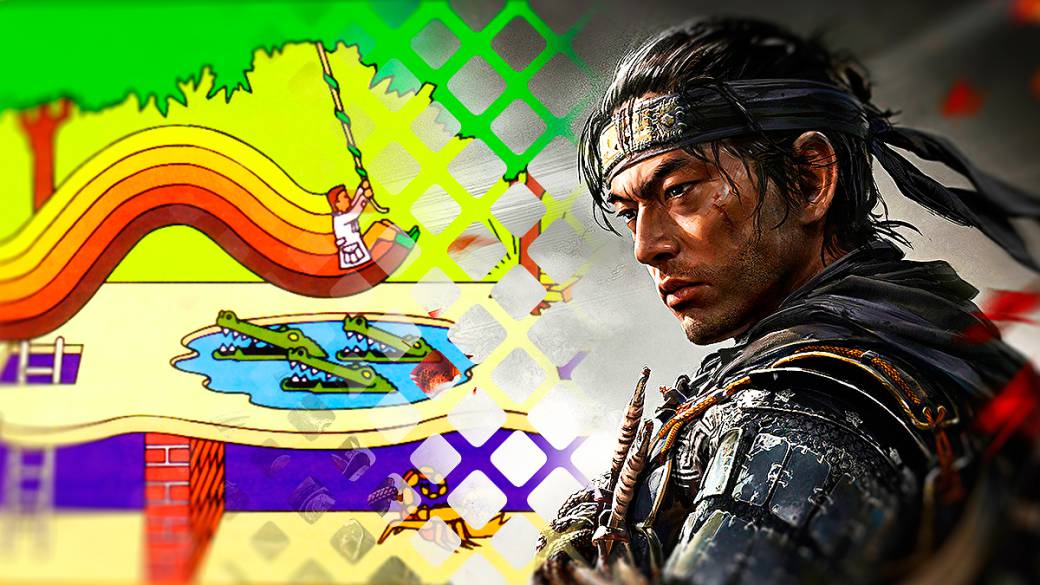
Join us on this exciting journey through the techniques and procedures that make cinematography in cinema a very important point of inspiration for many video game developers.
The breeze that surrounds us gently shakes grass and branches, while thunder in the distance is heard warmly. The cloudy atmosphere gives way to a somewhat more pronounced blizzard, while we walk among the battered inhabitants of the place: an overprinted text on screen in the middle of a playable sequence reads: invasion of the Mongols, day 8.
"Nobu, come!" We exclaimed with the aim of skirting the plains of Otsuna on the back of our faithful companion. At this moment, we change the decadent tones for some striking contrasts, the protagonism of which is given this time to the yellowish ocher colors that stain the cornfields. The first references to Zhang Yimou are immediate.
From there we will raffle forests where green predominates, we will attend brief cinematic scenes integrated in the playable experience that reminds us of the precision and austerity of the Takashi Miike of 13 Assassins, and we infiltrated a building whose careful interior lighting is bathed by the rays of the sun that enter through the Shōji. As expected, these delicate doors of translucent washi paper reveal the shadow of the enemy, at which point we have the opportunity to go through both – the door and abdomen of the aforementioned opponent – to make playable a regular scene from films like Takeshi Kitano's Zatoichi or Yojimbo from Akira Kurosawa.
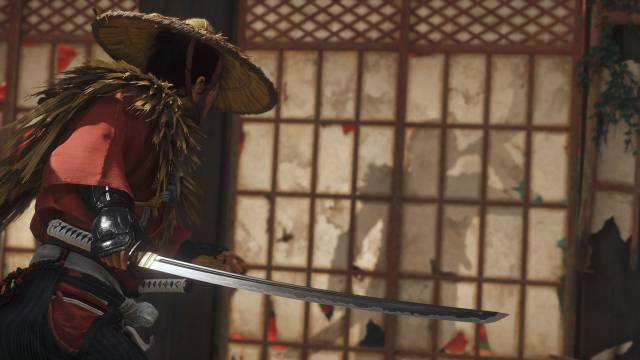
In this introduction we wanted to summarize the elements that make up a playable scene in video games. As is the case in cinema, and far from the general perception of what cinematography means (also called cinematography through its designation in English: cinematography), not only items such as the rule of thirds, that of 180º, or if we are in front of a detail plan, general or American, they are what worry the director about this important aspect.
Elements such as the lighting arrangement, the color composition in plane or the depth of field in the scene make video games like Ghost of Tushima need the figure of the cinematographer (s) to successfully carry out the work of the director. artistic. It is true: there are no people to handle the cameras, we do not have figures such as the director of the second unit, nor do we shoot in natural settings. But that does not happen in computer-generated films either, where figures at the height of Danielle Feinberg (director of photography at Pixar) or Rob Dressel (same position but in terms of layout) are fundamental figures.
“In the Hero movie, there are five colors as main narrative elements: black, white, red, green, and blue. Different colors represent different characters, their inner worlds and situations ”Xioyi Fu in A Look At The Color Narrative In“ Hero ”.
In the Sucker Punch game there are snippets of Xiaoding Zhao (Zhang Yimou's House of Flying Daggers), while the continuous playable sequence shot of God of War would not be the same without references such as Emmanuel Lubezki (Children of Men, by Alfonso Cuarón or El Renacido, by Alejandro Gonzalez Iñárritu), who keep up the pulse of the camera despite the continuous filming minutes accumulating.
It is possible that the figure of the cinematographer was not fundamental in video games until relatively recently – contemporary production being the most needed of this figure, especially in high-budget titles and determined three-dimensional artistic direction – and even today in day is called differently or is diluted within the 3D department in several alternative figures (such as the lighting director or the person in charge of cinematic sequences). Be that as it may, from Day of the Tentacle to Cyberpunk 2077, through the Resident Evil, Metal Gear or Silent Hill of PS One, the need has always been solved, regardless of the position taken by the competent people of each interactive production.
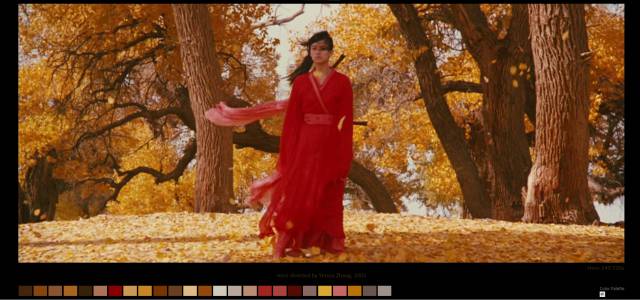 Color plays a major role in the cinematography of the movie Hero.
Color plays a major role in the cinematography of the movie Hero.
We must bear in mind that there are several figures and diverse elements that make up the cinematography of a film. The lighting of the shot is set by the cinematographer, taking into account elements such as color temperature, the time of day that is to be reflected or if the scene is bathed in natural, artificial or both kinds of light. Following the instructions and style of the cinematographer, the camera will be in charge of composing the shot with the help of the camera assistant and assistants. All this under the careful supervision of the construction manager.
As we can see, many of these elements have to be perfectly coordinated also in the videogame sector, since the staging of certain interactive productions are directly inspired by well-known film productions and figures at the height of Roger Deakins or Vittorio Storaro .
The resource economy
The beginning of the history of the video game was characterized, among many other aspects, by the need imposed due to the limitations of the systems of the time. It has also happened throughout the history of cartoons for film and television: animation Limited to low frame rate, hand-painted backgrounds with one or more two-dimensional layers of depth, or the predominance of flat colors in characters in contrast to the watercolors or acrylics that gave more detailed results on stage.
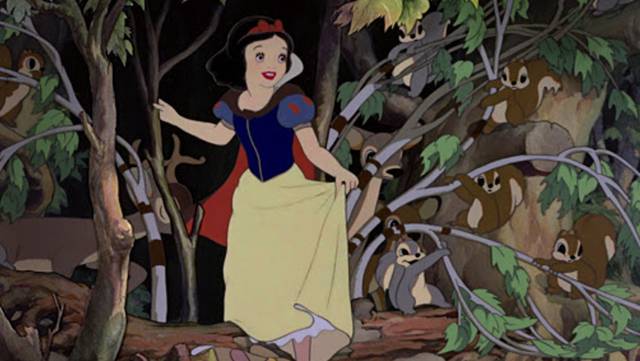
The problem was obvious: painting a fundamentally static scene was not the same as generating the thousands of frames that would make up the movement of the characters in each shot. Translating to the interactive terrain, the memory limitations meant that the characters could not count on a large number of frames for animation, that these were the smaller the better, and the planes on screen were fundamentally static. Taking the Pong or Space Invaders video games as an example, we could say that everything was shown through a general shot without camera movement.
With scrolling in video games we begin to obtain the first pieces of interactive travellings. Let's remember; before that Pitfall! it allowed us to move horizontally as we advanced through the stages, but the backgrounds did not move: it was the character who, going from left to right, avoiding many traps and pixelated dangers, “appeared” on a new screen giving the sensation of exploration.
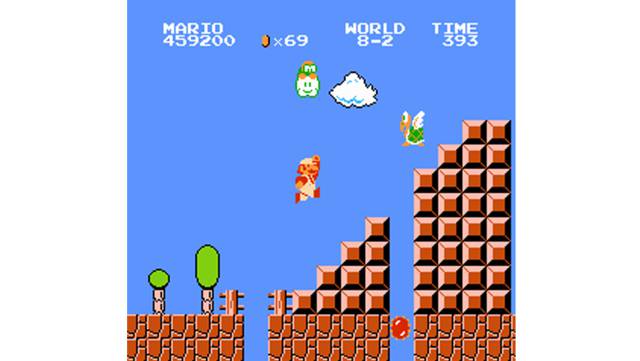
There was a lot of debate: today it can be laughable, but when Shigeru Miyamoto and Takashi Tezuka proposed scrolling in Super Mario Bros. many doubted whether to see the character in the center of the screen while the elements of the stage and the enemies moved the player would get dizzy. More parallels: One of the first moving motion picture sequences shown in the world of cinema (the famous train approaching the screen) caused people to flee the room. Other times. To understand in a general way the intention of the traveling, Esther Miguel Trula's description in Xataka seems to us correct:
"A traveling is a walk through the image that invites you to believe that the camera could be you, moving with the characters, as if receiving a push that requires you to believe that you are living the scene you are contemplating."
Fortunately, the scroll was a success, putting several layers of depth added realism to this kind of shot with interactive traveling in titles like Moon Patrol or Wonder Boy, and figures like Shigeru Miyamoto or Dave Perry, unknowingly adopted the figure of director of photography when making these creative decisions. As we say, that the specific figure was not there does not mean that the task was not carried out.
In Wes Anderson's cinema we can see perfectly how the use of traveling can define a director's personality. Using multiple side shots of films such as Isla de Perros or Gran Hotel Budapest, large lateral shots with camera movements parallel to the action represented on the screen (lateral advance videogame style), cinematographer Robert Yeoman performed small visual miracles. On the other hand, who knows if Tristan Oliver was inspired by the interactive universe to endow his shots with the parallax charm that reinforces many scenes of Isla de Perros?
 In Isla de Perros, many scenarios were configured for filming from a lateral point of view.
In Isla de Perros, many scenarios were configured for filming from a lateral point of view.
Without a doubt, they have some points in common: these are the use of symmetry and the focus of various scroll planes, as well as the elaboration of the staging following the parameters of the two-dimensional representations:
"I think it is very much in line with his (speaking of Anderson) preference for the two-dimensional, his longing for a great depth of field, to seek that they are almost illustrations rather than a dimensional world. A silhouette is the flattest thing there is, so we always tended to it. ” Interview with Tristan Oliver on cameraandlightmag.com
Of the various types of traveling, it is the "accompaniment" that is most similar to what we can see in video games, both when the camera moves horizontally and when it moves vertically.
From lateral description to cinematographic shot
The interactive systems were advancing, the sprites were getting bigger and more detailed, and the ways of showing the interactive scenic space were richer and more varied. Titles like Maniac Mansion 2: Day of the Tentacle are perfect for analyzing some of the classic shots used in cinema, inherited directly from the video game industry.

Being one of the most common the general shot or the large general shot, perfect to show some beautiful scenarios in conical perspective from a central point of view, we can also observe the use of the American shot (perfect for organizing various characters during an important situation , framed at the height of the legs), the close-up (ideal to emphasize a dramatic scene) or the detailed shot (used to frame an item from closer).
Titles like Another World or Earth of Darkness also pioneered the use of multiple planes combined to create a coherent visual narrative in their vector cinematic scenes. Eric Chahi resorted to Another World, as in other video games of his original career, to the use of rotoscopy to add an unusual realism for the time.

To all this we must add another fundamental aspect within the staging of an audiovisual work: the format. As was evident, 4: 3 were imposed from the beginning of the history of the video game as it was used on home televisions. Although it is true that we have exceptions in titles at the height of Space War or Speed Race —with a spherical screen in the first instance and a monitor placed vertically for the second—, video games in an almost square format were the predominant ones.
It would not be until the appearance of the three-dimensional phenomenon in video games, when many of these elements would undergo a revolution at the height of what the new playable dynamics represented, the genres that came from the hand of 3D and, in general, the feedback they have suffered —And continue to experiment— the cinematographic and interactive scenic spaces.
Views in playable staging
The total set of the aforementioned changes revolves, both in relation to the direction of photography in particular and in the visualization of the playable scene in general, around the appearance of the virtual camera.
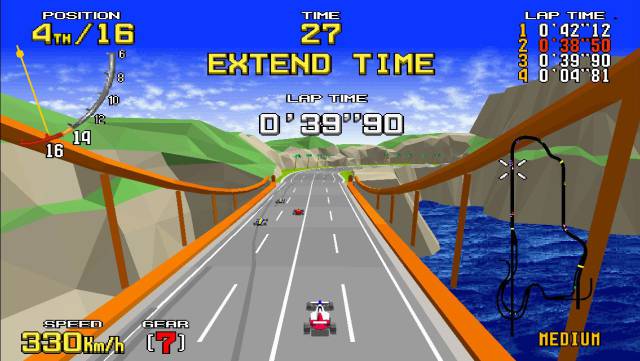
With the first 3D film productions and video games that used vector graphics in advance – we are talking about Hard Drivin, Starwing or Virtua Fighter, to give several examples at different times in video game history – a new horizon was glimpsed in ahead, in need of more attention in terms such as the angle shot, the zenith plane, or the focal length by which different visual sensations could be expressed.
Speaking of the latter case (that of focal length), driving games like Daytona Usa were shown through virtual “wide-angle” lenses to, in the first instance, allow the viewer to see more elements of the stage (remember that screens were still used 4: 3) and, secondly, to emphasize the sense of speed: the scale of the elements was exaggeratedly accentuated as they approached our racing car.
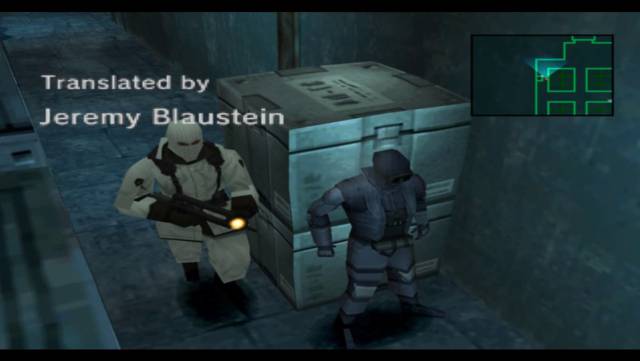
This technique did not work as well in video games of the adventure genre, so we opted for lenses that were closer to human vision —in order that the characters did not deform too much nor did the elements that made up the scenarios “lengthen ”Approaching the limits of the screen – in the staging of titles at the height of Metal Gear Solid or The Legend of Zelda: Ocarina of Time. We can place its equivalency in film and photography cameras to record through a lens between 30mm and 50mm.
Another of the elements we have mentioned can be directly exemplified by another well-known Konami video game: Silent Hill, visually inspired by the cinematography of films such as The Shining of Stanley Kubrick or The Ladder of Jacob by Adrian Lyne. We are talking about terms like the front shot, the low angle shot or the zenith, which have directly to do with the camera's position and its height while focusing on an element or character on the scene from various angles.
Ground-level shots that follow the movement of a hospital gurney, shot shots that show the characters from unusual angles in film history and camera movements that intermingle with various frequencies in the shutter speed of the lenses. They belong to the film, although they could very well describe Silent Hill's camera movement as an aesthetic component of their grotesque imagery.
However, nothing happens until Harry is attacked by little monsters at the end of the alley, he starts to run away and realizes that he seems to be trapped. The camera moves and spins as restlessly as Harry himself. This dynamic start is representative of Silent Hill's moving camera aesthetic. ” Bernard Perron in Silent Hill: The Terror Engine.
In the third part of the saga, Masahiro Ito was one of the people in charge of giving the video game the oppressive atmosphere so characteristic that it emerges, under the role of Drama Camera Director & CGI Director. As we can see again, figures who play roles equivalent to that of cinematographers in the cinema. As Bernard Perron states, “It is not only during cinematic scenes that the camera moves almost constantly. Follow the player character during gameplay from the front, side or behind ”

The horror genre has been very prolific in terms of experimentation within the world of cinematography in the interactive field. In both Alone in the Dark and Resident Evil, the position of multiple static cameras was played throughout the game to recreate a very characteristic visual narrative. They are great examples of using pre-rendered graphics for detailed scenarios, and polygonal techniques for recreating various characters, enemies, and objects. In a way, by scrolling through the sets, we became cinematographers while visiting the remembered sets of these games.
Once again, the diversity of points of view plays again an essential role: wide shots, American, angular, pitted, contrapied and all kinds of camera effects and focal lengths to emphasize the disturbing nature of the work. The achievements made by Sinji Mikami and his team were taken one step further in the Resident Evil remake for Gamecube, where all the scenarios were recreated with a care for detail never seen before, managing to compete with lighting and color quality. they got cinematographers like Javier Aguirresarobe (The Others) or Jonh Alcott (The Shining). Metered backlights, shadows cast through wooden bars, or warm light sources for interiors as opposed to vaguely moonlit exteriors in much cooler tones.
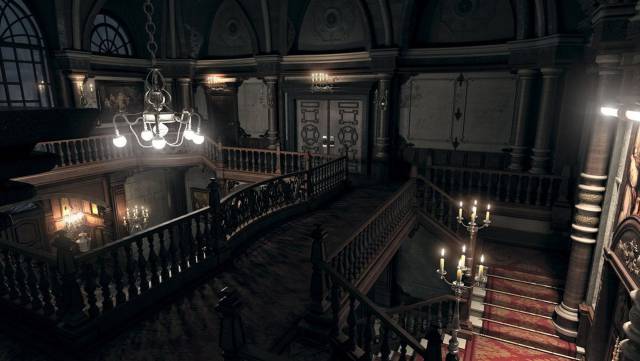
The saga has accompanied us throughout the history of video games and, currently, technological advances have allowed Resident Evil 2 (remake of the beloved video game of 1998) to show all the values explained above, powered under an interactive stage space generated in time real. Thanks to the joint work of Haruka Ishida (Lighting Artist and Composition Director) and Yasushi Kawamura (CG Director, also with experience in film directing Gantz: O) among many others, we can enjoy gloomy corridors illuminated by the external light of the moon through the windows of the police station, or offices where desks, documents and all kinds of complementary objects to the set are accumulated, as if we were watching a scene from a David Fincher film under the cinematography of Jeff Cronenweth.
From natural light to tungsten fluorescent
And since we are totally immersed in the concept of lighting, it is welcome to briefly explain some of the systems most used in photography, film, television and, how could it be otherwise, contemporary video games. And we say contemporaries because it is, for a relatively short time, finally possible to adapt lighting techniques within space in real time. Moments that we could only enjoy in the past through computer-generated cinematic scenes, today surprise us with lighting systems generated in real time. And it is in the general adaptation of elements such as HDR or Raytracing where the latest advances in this regard reside: the limits for interactive cinematographers are dissipating.
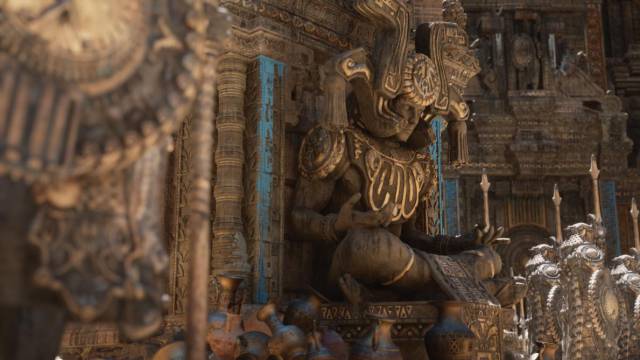
Many of you may have noticed, in titles like Uncharted 4, that the lighting during gameplay differs from what we can enjoy in cinematic scenes. This has a justification, beyond that in many video games in these scenes (being more controlled) complex effects and shaders are used. As in the cinema, during dialogues the aim is to focus the viewer's attention on the characters and their faces, using various established lighting techniques.
The most common is three-point lighting. In this system we have the main light (which illuminates the character's face from one side, almost frontally but angled enough to generate volumetric shadows under the eyebrows and on the nose), the secondary light (which is used to subtly fill the area of the face less illuminated by the main one) and the silhouette light (located behind the character, most of the time on the side opposite the main light, which is responsible for generating a smooth contour with the aim of separating the actor from the stage). If we look into the eyes of the protagonists, we can see the main light reflected through a white point of great intensity. Often, secondary is also evidenced in a similar way.
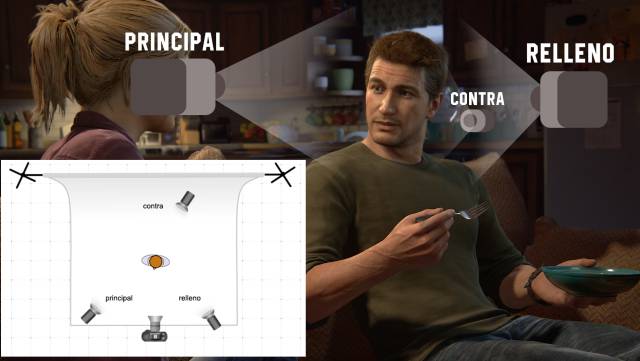 Example of a three-point lighting system in Uncharted 4.
Example of a three-point lighting system in Uncharted 4.
At this point it is welcome to talk about Vagrant Story, one of the first video games to simulate silhouette light — the technical possibilities at that time were very few — using ingenious tricks of duplicating geometry. This new geometry would be completely traced to the previous one, only displaced and overlighted enough to give the feeling that a rear source illuminates the characters. In this case, it is Jun Akiyama (Director of Cinematic Scenes) who takes the role of director of photography to also give us rich angular shots, well-measured camera movements and a prodigious visual narrative for the time, which he surpassed in many ways. to Hideo Kojima's work with Metal Gear Solid.
Very important is the role of Jun Akinawa, event director of Vagrant Story, who was responsible for the integration of the cinematics with the gameplay so that all the staging of the video game in question was as smooth as possible. As you can imagine, a colossal project considering that Playstation was one of the first consoles to manage three-dimensional graphics with texture mapping. If we read Jun Akinawa, we can intuit the hard work that this aspect meant when he affirmed that “we have taken care to maintain smooth transitions between the events of the game, ensuring the quality of the scene, in order to improve the tempo of the whole story. Technically precise manipulation of the characters' eyes and mouths, their facial expressions, and their changes are used to subtly display their emotions. Wide angle, telephoto and fisheye lenses helped solve a number of new problems that arose in this process. "
"3D gaming was a new challenge for our team, but the hard work redesigning the camera shots through a long trial and error process yielded the results we wanted." Jun Akinawa in Vagrant Story, from the Developer Team.
Apart from the three-point system, there are cinematographers who are characterized by giving their scenes a very particular lighting, where the temperature of the light is very important to add realism to the shot. The most common scale goes from the coldest light (when focusing on a clear sky), going through the balanced light generated by a white fluorescent tube, to the warmest one (the one emitted by candles is usually used as a reference).
In addition, while there are movies where complex lighting systems (spotlights that imitate sunlight, large white screens that bounce light rays returning a light source that casts soft shadows, deflectors of all kinds) are combined with chromas to Integrating the special effects later, as in Avengers (Trent Opaloch) style movies, other directors hardly ever use cinematographic lamps and spotlights, in order to keep an aspect closer to the mundane or realistic stories they want to describe.
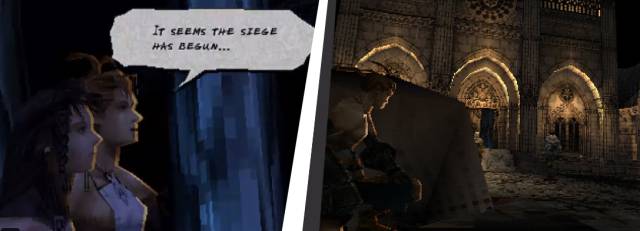 Vagrant Story, one of the first titles to simulate a rear light source, which defines the relief of the characters and detaches them from the background.
Vagrant Story, one of the first titles to simulate a rear light source, which defines the relief of the characters and detaches them from the background.
It happens in the joint work of Koreeda, Yutaka Yamazaki and Mikiya Takimoto in films such as After the storm or Of such a father such a son, while in the Mindhunters series, David Fincher chose Erik Messerschmidt to make the interior environments as natural as possible . We will not routinely see reflected light sources in characters' eyes with classic white dots. Nowadays, the technique allows to equip the latest generation video games with these characteristic lighting aspects, thanks to the combination of real-time lighting techniques, complex lightmapping and advanced ambient occlusion.
Aymeric Montouchet, director of photography for Detroit: Become Human, has many points in common with the cinematography of films like those of Fincher, so we can find concrete parallels between Mindhunters and Dave Cage's video game. Interior scenes subtly illuminated by the lights present on the scene (lamps, fluorescent tubes, indirect lights coming from outside); all this bathed by color temperatures of slight relevance: many moments the cold tones flood the room, but it is the warm and yellowish ones that give us a feeling of more scenic realism, and incidentally they also transfer us to the characteristic character of films such as Lost.
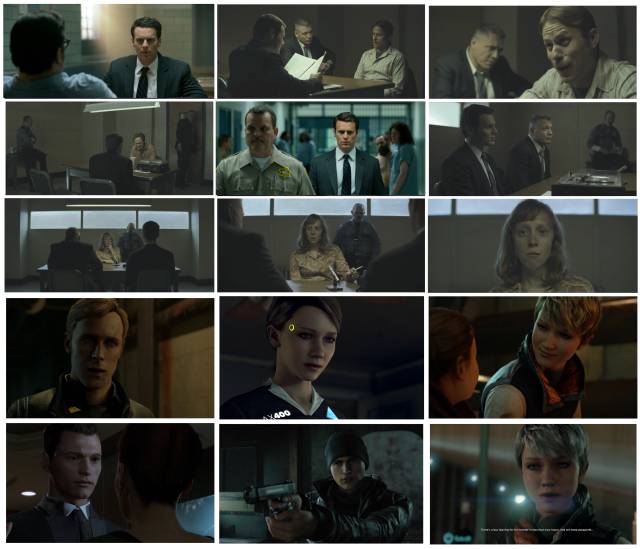 Detroit: Become Human and the Mindhunters series share common ground for cinematography.
Detroit: Become Human and the Mindhunters series share common ground for cinematography.
The other side of the coin would be found in productions such as inFamous: Second Son and, even more obviously, in First Light: the blockbuster uses multiple light sources, neons that are reflected in the wet roads of Seattle, as a visual reference, and protagonists bathed in electricity, fire and all kinds of special effects, as if it were a Marvel production. We'll see where the cinematography shines in the next Avengers video game.
From sequence shot to modern western
Thinking analytically, the sequence plane is what would define the world of the video game. Without cuts, showing the action continuously, and giving the right visual narrative to offer us a clear visual idea of what is happening on screen. In platform video games, that sequence shot is cut when we change phases. In contemporary action movies, the sequence shot behind the character that accompanies us while we play is interrupted by loading screens, the entrance of cinematic scenes or the "Game Over", to give several examples.

There is no continuous sequence shot in video games, like those we have been able to experience in the world of cinema through films like Birdman (it is true, there are tricks in filming it so that everything seems resolved in a single shot, although the continuous scenes that They make up everything are incredible) although the closest thing we can find would be located in the incredible God of War, of which our partner José María Villalobos spoke long and hard in this report. In this video game, emulating the epic of cinematographers such as Emmanuel Lubezki (Birdman, Gravity or The Reborn) or Jörg Widmer (A Hidden Life), the wide-field angle camera defines the playable scene while staying on the protagonist's shoulder.
During the cinematic scenes there is no cut: the camera takes off from the protagonist to become the viewer while focusing on what is happening on screen, running towards the characters, ducking while an enemy of terrible proportions tries to finish off Kratos … As if from endless sequences of The Reborn is about, God of War's cinematography is wonderful, making in practical terms a single sequence shot only interrupted by the player's access to the menus or when we succumb to some powerful adversary.
"The camera was essentially an additional character in the scenes. The intention was to create a deeper immersion in the story and to promote a stronger empathy towards the characters, by making the viewer feel like they are literally taking the journey with our hero." Dori Arazi in an interview for Variety.
The miracle is made thanks to the good work of the cinematographer Dori Arazi, the virtual pulse of Zach Demas (Camera operator) and the talent of Megan Golbeck (The person in charge of the narrative action, who has also worked with James Cameron in the department render icon). Names with positions equivalent to what they would have in a film production, so in this case the importance of directing photography in the field of interactive production is evidenced by assigning specific roles.
The Red Dead Redemption 2 case is also commendable. On this occasion, two aspects of cinematography stand out within the genre. On the one hand, the events happening around us while we control John Marxton are of unprecedented quality. While we walk through the camp, our colleagues will interact with us in real time, integrating us into conversations where other guests can join us, being the player participating in scenes directed with great taste for detail and where, contrary to what happens in the cinematics, we never lose control of either the camera or the character. Choosing where to focus and at what moments, it is as if the player himself became director of the second unit.

An outlaw flying through the Saloon window to end up near our horse, shootings that originate from gang conflicts, assaults on our person that surprise us in the middle of the night … Red Dead Redemption 2 is characterized by Take the feeling of life within an open-world video game to a new level, a fact made possible by figures such as Matt Podaski (Motion Capture Unit), Thomas Diakomichalis (Motion Design Director), Nathan Hunt (Director of Photography) in interactive cinematic scenes) and Owen Sheperd (Lighting Director).
And this does not stop here, since the references to classic and contemporary cinema within the western world are clear in this Rockstar video game. In the cinematic scenes of Red Dead Redemption 2 we can see clear references to the western, beyond the many American shots that are shown during Marxton's journey. De nuevo, el director de fotografía Robert Deakins vuelve a ser la inspiración, tanto en la iluminación como en la organización de los planos: sirvan como ejemplo las imágenes comparativas que nos acompañan, donde películas como True Grit o El asesinato de Jeese James por el cobarde Robert Ford. También la temperatura de color y el estilo de lentes utilizados por Robert Richardson en Los Odiosos Ocho, de Quentin Tarantino, son signos muy utilizados en el diseño de escenas interiores en Red Dead Redemption 2.
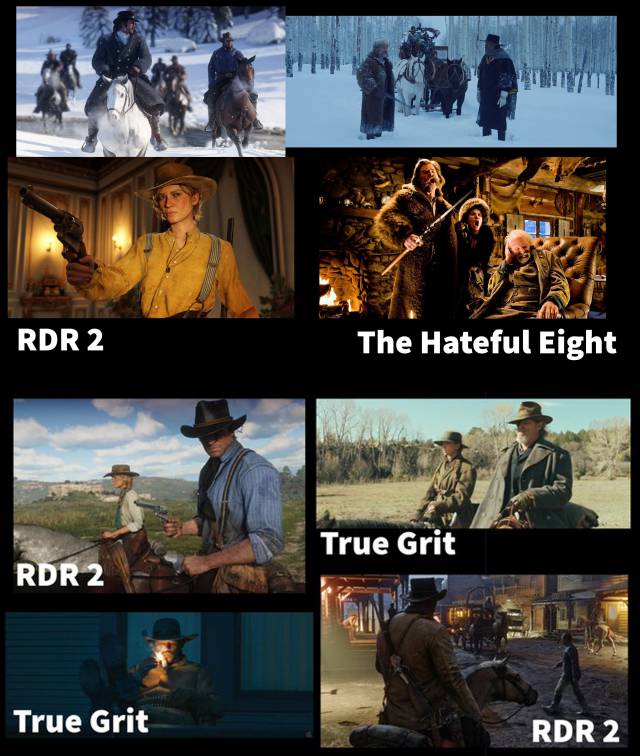
Una nueva época para soñar
Como hemos comentado con anterioridad, hay determinados aspectos que configuran el acabado visual de una película. Por una parte: las lentes y la profundidad de campo son elementos que marcan la diferencia a la hora de disfrutar de estas tomas tan características donde los personajes aparecen en primer plano, mientras que el fondo se mantiene desenfocado. Es en la actual generación de sistema de entretenimiento donde hemos podido disfrutar de un bokeh (desenfoque del fondo) más realista debido a la posibilidad de limitar la profundidad de campo.
Títulos como Uncharted 4 o Ghost of Tsushima se pueden considerar buenos ejemplos en este campo: luces distorsionadas en formas romboidales, suaves desenfoques que centran la atención del espectador en los motivos principales de la escenas, y una combinación de diferentes lentes para conseguir una narrativa visual no exenta de gran dramatismo.

Elementos que, en el cine, rompen la cuarta pared (estamos hablando de cuando en películas bélicas la sangre salpica la cámara de, en teoría, el operador encargado de documentar los hechos en primera línea), tienen su equivalente en el sector interactivo en momentos como cuando las gotas de lluvia salpican el casco de Samus en Metroid Prime, o en títulos como Heavy Rain. Estamos deseando ver cómo estos efectos de postprocesado dentro del campo interactivo son representados en un futuro próximo.
José María Villalobos, autor de Cine y Videojuegos: un diálogo transversal, lo explica muy bien afirmando que "en los créditos iniciales de Heavy Rain las gotas de lluvia salpican en algunos momentos la lente de la cámara. El carácter ficcional de la historia —un thriller sobre el dolor y la pérdida que se sostiene totalmente en la psique de sus personajes— podría convertir ese detalle en un error técnico, pero es que Heavy Rain no es una película, de hecho no hay cámaras físicas que hayan rodado esas escenas, el efecto se ha creado artificialmente. En el juego producido por Quantic Dream y dirigido por David Cage se introduce ese elemento para dar la sensación de un rodaje real"
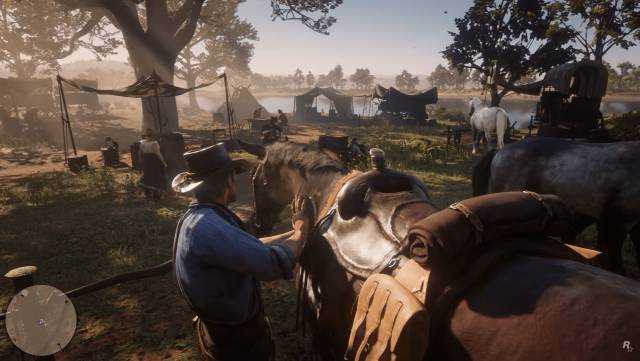
También la velocidad de apertura del diafragma en las cámaras cinematográficas establece diferentes sensaciones dentro de la escena. Si es lenta, los objetos en movimiento tenderán a desenfocarse, mientras que si es lo suficientemente rápida, los fotogramas estarán perfectamente definidos si pausamos la imagen aunque se los motivos se muevan a gran velocidad. Directores como Ridley Scott (Gladiator) o Michael Mann (Collateral) son famosos por combinar distintas frecuencias de fotogramas, velocidades de apertura e incluso formatos cinematográficos, gracias al buen hacer de figuras a la altura de John Mathieson en el primer caso, o de Dion Beeb en el segundo.
Con los sistemas de desenfoque de movimiento actuales se ha avanzado enormemente. Uno de los videojuegos que se adelantó a su tiempo en este sentido, en consolas, fue el recordado Killzone 2. Por su parte, Crysis también demostró el potencial de la técnica allá por el año 2007 en los PC que podían mover esta bestia técnica. A día de hoy, el desenfoque de movimiento se utiliza tanto para aportar fluidez a los movimientos de personajes y objetos (Metal Gear Solid V, Final Fantasy VII Remake) como para intentar mejorar el movimiento de videojuegos que no superan los 30 fotogramas por segundo.
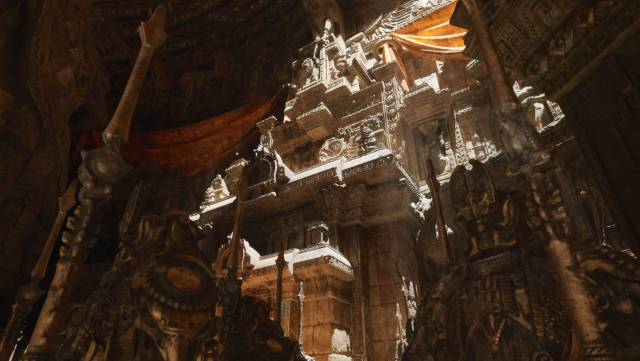
Otros efectos de postprocesado ayudan a integrar más aún el realismo cotidiano al entorno interactivo: el destello del sol casi nos deja deslumbrados si lo miramos directamente en videojuegos como Horizon: Zero Dawn, mientras que determinados filtros de postprocesado permiten dotar de profundidad, complejidad y volumen a los escenarios más ambiciosos. El futuro que nos deparan estas técnicas en el futuro es brillante. Con la globalización de HDR, la introducción de estándares como el Ray Tracing o la implementación de novedades en el campo del modelado y texturizado complejos, no podemos esperar a poder disfrutar la nueva época dentro de la historia del videojuego.
—
En este artículo ha colaborado José María Villalobos, autor especializado en cine y videojuegos, escritor de 'Te regalo el fin del mundo' y 'Cine y Videojuegos: un diálogo transversal' y colaborador de Meristation.
Referencias:
CULHANE, Shamus ( 1988): Animation. From Script to Screen, Nueva York: St. Martin’s Press, 336 págs.
CRAFTON, Donald (1990): Emile Cohl. Caricature and Film, Nueva Jersey-Oxford: Princenton University Press, 404 págs.
FURSSEDONN, Mark (2011): Panavision, the biggest red book yet, Londres: Panavision Press, 70 págs.
HECHT, Hermann (1986): Pre-Cinema History. An Encyclopaedia and Annotated Bibliography of the Moving Image Before, Londres: Browker-Saur, 1993, 476 págs.
MASCELLI, Joseph V. (1998). The five C's of cinematography. Los Angeles: Silman-James Press, 249 págs.
PASTOR MOLINA, Alejandro; PAVÍA COGOLLOS, José y HERRÁIZ ZORNOZA, Beatriz (2013) La dirección de fotografía de Emmanuel Lubezki a través de los ojos de Terrence Malick: de The New World (El nuevo mundo) a The Tree of Life (El árbol de la vida), Gandía: UPV: Escuela Politécnica Superior de Gandía.
PERRON, Bernard (2011). Silent Hill: The Terror Engine, Michigan: University of Michigan Press.
RAJAS FERNÁNDEZ, Mario y GARCÍA GARCÍA, Francisco. (2008). La poética del plano-secuencia. Madrid: Universidad Complutense de Madrid, Servicio de Publicaciones, 761 págs.
Eastman Kodak Company (2007). Motion Picture Color Theory (pdf). Rochester, Nueva York. Disponible en: https://www.kodak.com/uploadedfiles/motion/US_plugins_acrobat_en_motion_education_colorTheory.pdf
Bradley, A., & Bradley, A. (2020). ‘God of War’s’ Single-Shot Approach Inspired By Language of Film , Broadway (online). Disponible en: https://variety.com/2018/gaming/features/god-of-war-single-shot-camera-1202793441/ (Consultado el 1 de mayo de 2020)
Fu, X. (2017). A Look At The Color Narrative In “Hero” – Newhouse Insider (online). Disponible en https://newhouseinsider.syr.edu/2017/11/a-look-at-the-color-narrative-in-hero/ (Consultado el 10 de abril de 2020)
IMDb: Ratings, Reviews, and Where to Watch the Best Movies & TV Shows (online). Disponible en: https://www.imdb.com/ (Consultado el 2 de mayo de 2020)
Massanet, Adrián. (2011). La dirección de fotografía (online). Disponible en: https://www.espinof.com/diccionario-cine-television/la-direccion-de-fotografia-1 (Consultado el 28 de abril de 2020)
Softs, L. (2020). Camera & Light Mag: 'Isla de Perros', Animación de Autor (online). Disponible en: https://www.cameraandlightmag.com/noticias/isla-de-perros-animacion-de-autor/1# (Consultado el 5 de mayo de 2020)
Trula, Esther. (2020). Los mejores travelling de la historia del cine, reunidos en este increíble vídeo-mashup (online). Disponible en: https://magnet.xataka.com/un-mundo-fascinante/el-video-que-resume-la-genialidad-del-uso-del-travelling-en-la-historia-del-cine (Consultado el 13 de abril de 2020)
VAGRANT STORY : from the Development Team (online). Disponible en https://web.archive.org/web/20020808121151/http://www.playonline.com/archives/psgame/vagrantstory/flb/stuff/02.html (Consultado el 22 de abril de 2020)

